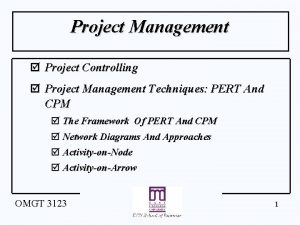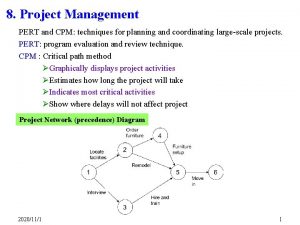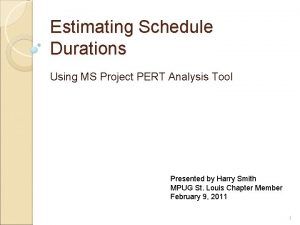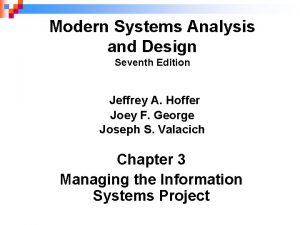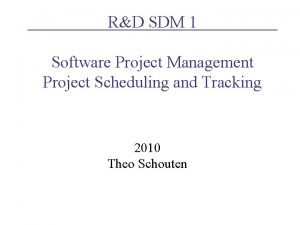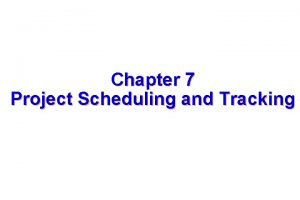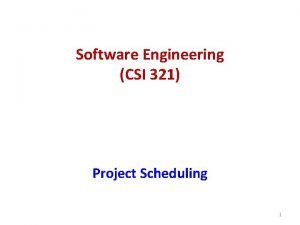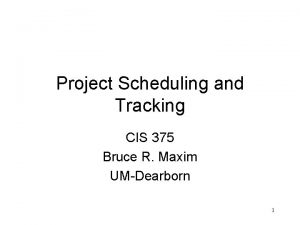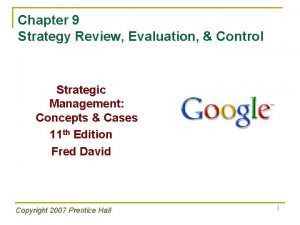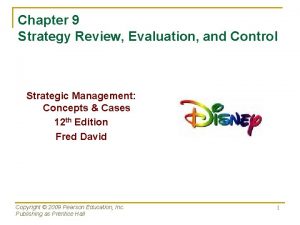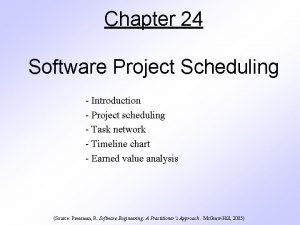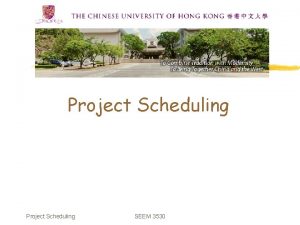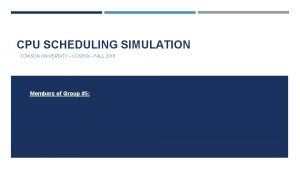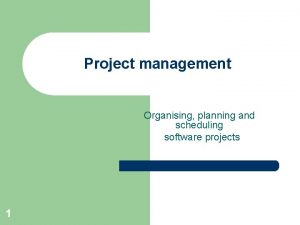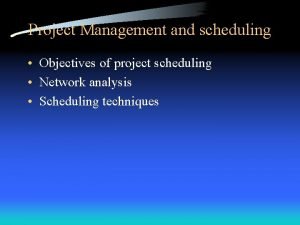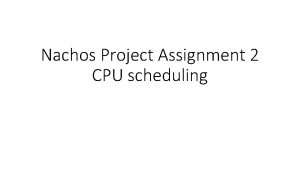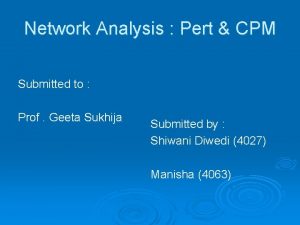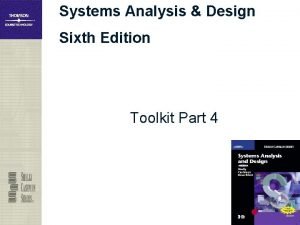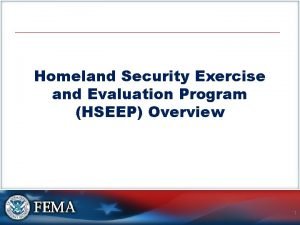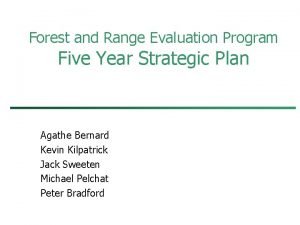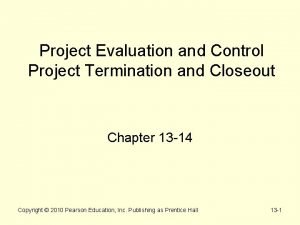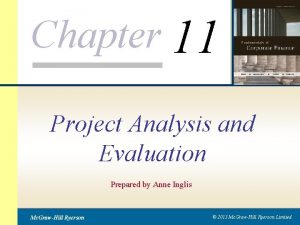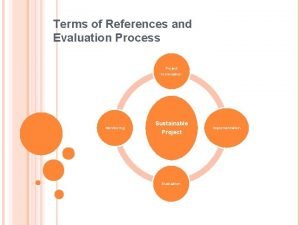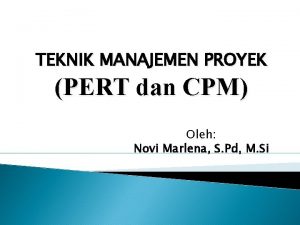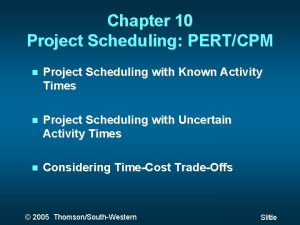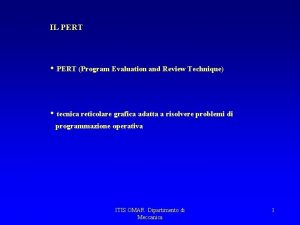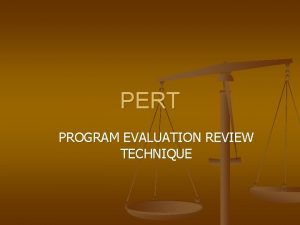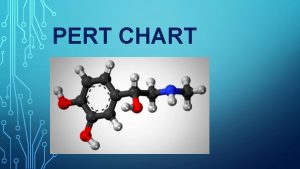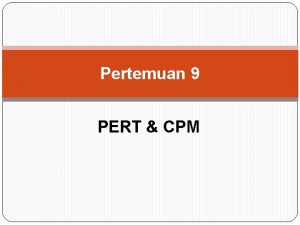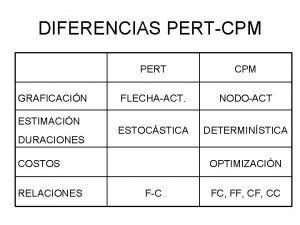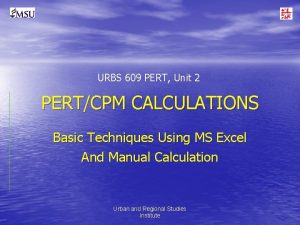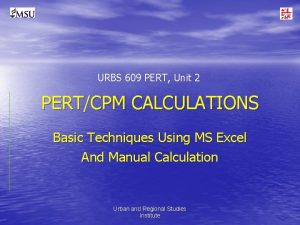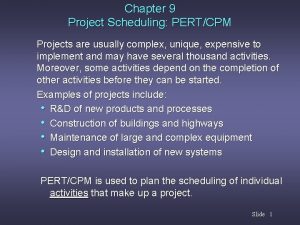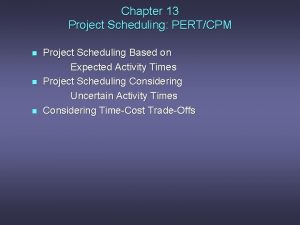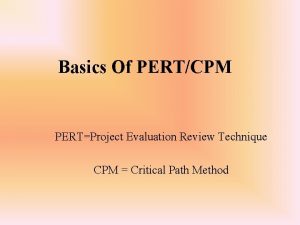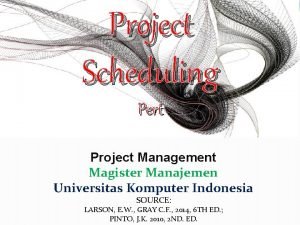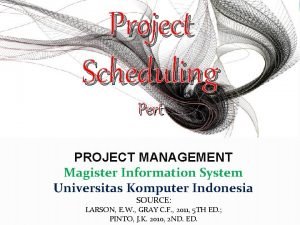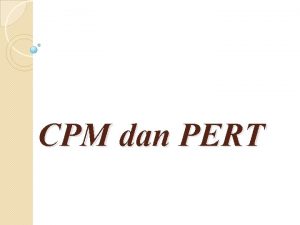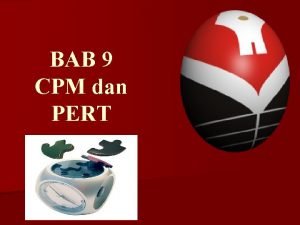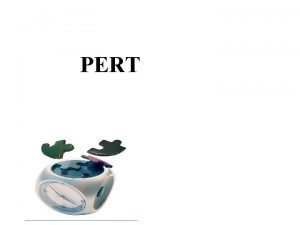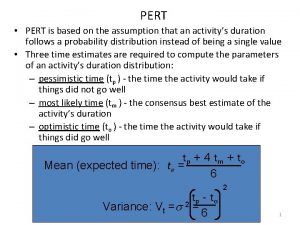Project Scheduling PERTCPM PERT Program evaluation and review
































- Slides: 32

Project Scheduling: PERT-CPM

PERT (Program evaluation and review technique) and CPM (Critical Path Method) makes a managerial technique to help planning and displaying the coordination of all the activities.

Activity Immediate Estimated Activity Description Predecessors Time A B C D E F G H I J K L M N Excavate Lay the foundation Put up the rough wall Put up the roof Install the exterior plumbing Install the interior plumbing Put up the exterior siding Do the exterior painting Do the electrical work Put up the wallboard Install the flooring Do the interior painting Install the exterior fixtures Install the interior fixtures A B C C E D E, G C F, I J J H K, L 2 weeks 4 weeks 10 weeks 6 weeks 4 weeks 5 weeks 7 weeks 9 weeks 7 weeks 8 weeks 4 weeks 5 weeks 2 weeks 6 weeks

Immediate predecessors: For any given activity, its immediate predecessors are the activities that must be completed by no later than the starting time of the given activity.

AOA (Activity-on-Arc): Each activity is represented by an arc. The arcs are used to show the precedence relationships between the activities.

(Estimated) Time arc node START 0 A 2 B 4 C 10 D G 6 E 7 I 7 4 F 5 J 8 K 4 H 9 L 5 N 6 M 2 FINISH 0

Path and Length START A B C D G H M FINISH 2 + 4 + 10 + 6 + 7 + 9 + 2 = 40 weeks START A B C E F J K N FINISH 2 + 4 + 10 + 4 + 5 + 8 + 4 + 6 = 43 weeks Critical Path START A B C E F J L N FINISH 2 + 4 + 10 + 4 + 5 + 8 + 5 + 6 = 44 weeks

Critical Path: A project time equals the length of the longest path through a project network. The longest path is called “critical path”. Activities on a critical path are the critical bottleneck activities where any delay in their completion must be avoided to prevent delaying project completion.

ES : Earliest Start time for a particular activity EF : Earliest Finish time for a particular activity

START 0 ES=0 2 EF=2 A C D ES=16 6 EF=22 7 ES=22 EF=29 G H 9 M 2 ES=6 10 EF=16 ES=2 B 4 EF=6 I 7 ES=16 4 EF=20 EF=23 E ES=20 5 F EF=25 J 8 K 4 L 5 N 6 FINISH 0

If an activity has only a single immediate predecessor, then ES = EF for the immediate predecessor. Earliest Start Time Rule: The earliest start time of an activity is equal to the largest of the earliest finish times of its immediate predecessors. ES = largest EF of the immediate predecessors.

START 0 ES=0 2 EF=2 A ES=2 B 4 EF=6 ES=6 C 10 EF=1 D I ES=16 6 EF=22 4 EF=20 E ES=22 ES=20 7 5 EF=29 G F EF=25 J ES=29 H 9 EF=38 K 4 ES=33 EF=37 M 2 ES=38 EF=40 N 6 FINISH 0 ES=44 EF=44 ES=16 7 EF=23 ES=25 8 EF=33 L 5 ES=33 EF=38 ES=38 EF=44

LS: Latest Start time for a particular activity LF: Latest Finish time for a particular activity Latest Finish Time Rule: The latest finish time of an activity is equal to the smallest of the latest finish times of its immediate successors. LF = the smallest LS of immediate successors.

LS=0 START 0 LF=0 2 LS=0 LF=2 A LS=2 B 4 LF=6 10 LS=6 LF=16 D LS=20 I 7 LS=18 LS=16 6 LF=26 4 LF=20 LF=25 E LS=26 LS=20 7 5 LF=25 LF=33 G F LS=25 8 J LF=33 LS=33 H 9 LS=34 LS=33 K 4 LF=42 5 L LF=38 LS=42 M 2 LF=44 N 6 LS=38 LF=44 LS=44 FINISH 0 LF=44 C

Earliest Start Time Latest Start Time S=( 2, 2 ) F=( 6, 6 ) Earliest Finish Time Latest Finish Time

Critical Path START 0 S=(0, 0) 2 F=(2, 2) A S=(0, 0) F=(0, 0) S=(2, 2) B 4 F=(6, 6) S=(6, 6) C 10 F=(16, 16) S=(16, 18) S=(16, 16) D S=(16, 20) I 7 F=(23, 25) 4 6 F=(20, 20) F=(22, 26) E S=(22, 26) 5 S=(20, 20) 7 S=(25, 25) G F=(29, 33) F=(25, 25) F 8 F=(33, 33) J S=(29, 33) S=(33, 34) H 9 K 4 S=(33, 33) F=(38, 42) L 5 F=(37, 38) F=(38, 38) M 2 S=(38, 42) N 6 S=(38, 38) F=(40, 44) S=(44, 44) FINISH 0 F=(44, 44)

Slack: A difference between the latest finish time and the earliest finish time. Slack = LF - EF Each activity with zero slack is on a critical path. Any delay along this path delays a whole project completion.

Three-Estimates Most likely Estimate (m) = an estimate of the most likely value of time. Optimistic Estimate (o) = an estimate of time under the most favorable conditions. Pessimistic Estimate (p) = an estimate of time under the most unfavorable conditions.

Beta distribution o o Mean m : Variance: p

Mean critical path: A path through the project network becomes the critical path if each activity time equals its mean. Activity OE M PE Mean A 1 2 3 2 B 2 6 9 8 18 4 10 C OE: Optimistic Estimate M : Most Likely Estimate PE: Pessimistic Estimate Variance 1 4

Activities on Mean Critical Path A Mean 2 Variance B 4 1 C 10 4 E 4 F 5 1 J 8 1 L 5 1 N 6 Project Time

Approximating Probability of Meeting Deadline Assumption: A probability distribution of project time is a normal distribution. T = a project time has a normal distribution with mean and , d = a deadline for the project = 47 weeks.

Using a table for a standard normal distribution, the probability of meeting the deadline is P(T d ) = P ( standard normal = 1 - P( standard normal = 1 - 0. 1587 0. 84. ) )

Time - Cost Trade - Offs Crashing an activity refers to taking special costly measures to reduce the time of an activity below its normal value. Activity cost Crash cost Normal cost Crash Normal time Activity time

Activity J: Normal point: time = 8 weeks, cost = $430, 000. Crash point: time = 6 weeks, cost = $490, 000. Maximum reduction in time = 8 - 6 = 2 weeks. Crash cost per week saved = = $30, 000.

Time (week) Activity N C A 2 1 Maximum Cost Reduction Crash Cost ($1, 000) in Time per Week (week) Saved N C 1 $180 $280 $100 B 4 2 $320 $420 2 $ 50 J 8 6 $430 $490 2 $ 30 N: Normal C: Crash

Using LP to Make Crashing Decisions Let Z be the total cost of crashing activities. A problem is to minimize Z, subject to the constraint that its project duration must be less than or equal to the time desired by a project manager.

= the reduction in the time of activity j by crashing it = the project time for the FINISH node

= the start time of activity j Duration of activity j = its normal time Immediate predecessor of activity F: Activity E, which has duration = Relationship between these activities:

Immediate predecessor of activity J: Activity F, which has time = Activity I, which has time = Relationship between these activities:

The Complete linear programming model Minimize

One Immediate Predecessor Two Immediate Predecessors Finish Time = 40 Total Cost = $4, 690, 000
 Sjn scheduling
Sjn scheduling Pert metoda
Pert metoda Dummy activity in network diagram
Dummy activity in network diagram Ms project pert
Ms project pert Pert project management example
Pert project management example What is strategic assessment in software project management
What is strategic assessment in software project management Project scheduling in software engineering
Project scheduling in software engineering Compartmentalization interdependency effort validation r
Compartmentalization interdependency effort validation r Pnr curve in software engineering
Pnr curve in software engineering Project scheduling and tracking software quality assurance
Project scheduling and tracking software quality assurance Fedex balanced scorecard
Fedex balanced scorecard Rumelt's criteria of consonance
Rumelt's criteria of consonance Scheduling principles in software engineering
Scheduling principles in software engineering Project scheduling
Project scheduling Cpu scheduling project
Cpu scheduling project Schedule project management
Schedule project management Objectives of scheduling
Objectives of scheduling Cpu scheduling project
Cpu scheduling project Network analysis cpm
Network analysis cpm Pert and cpm
Pert and cpm Gantt and pert charts
Gantt and pert charts Implementing hrd programs
Implementing hrd programs Homeland security exercise and evaluation program
Homeland security exercise and evaluation program Forest and range evaluation program
Forest and range evaluation program M&e cycle
M&e cycle Putting it all to bed during project closeout includes
Putting it all to bed during project closeout includes Project evaluation and control
Project evaluation and control Project analysis and evaluation
Project analysis and evaluation Differentiate monitoring and evaluation
Differentiate monitoring and evaluation Project formulation
Project formulation Example of monitoring and evaluation in project proposal
Example of monitoring and evaluation in project proposal What is monitoring
What is monitoring Manajemen proyek backward pass
Manajemen proyek backward pass

